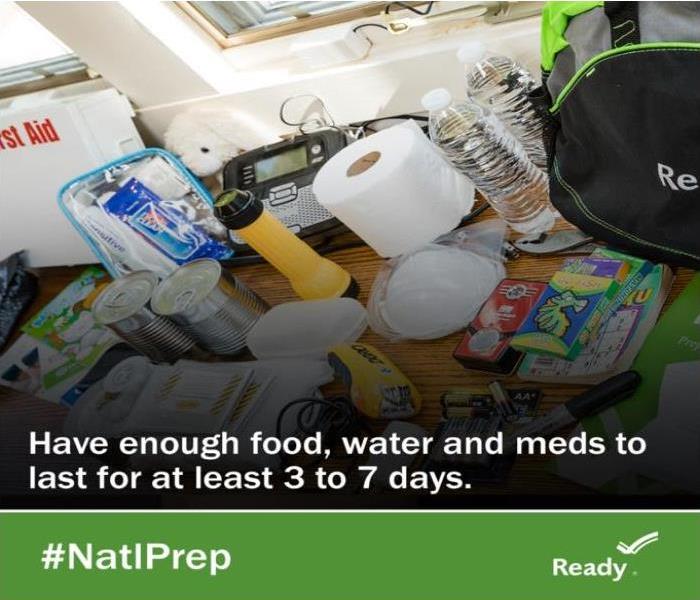National Preparedness Month -Week 2: Make a Plan to Prepare for Disasters Sept 8-14
9/9/2019 (Permalink)
 An emergency food storage of canned and nonperishable items, as well as bottled drinking water are essential. Plan ahead!
An emergency food storage of canned and nonperishable items, as well as bottled drinking water are essential. Plan ahead!
The only certain thing about disasters is that nothing is certain about disasters.
Natural or manmade, a disaster can happen at any time, and your family may not be together when they strike. Having a plan in place can help your family reconnect with one another and maximize their safety. But you have to plan to make a plan, and Ready.gov has the steps that you need to do this.
Step 1: Answer these questions
- How will we receive emergency alerts and warnings?
- What is our shelter plan?
- What is our evacuation route?
- What is our family communication plan?
The discussions that these questions will lead to can build the foundation of your family’s disaster strategy. What emergency alerts are available?
Wireless Emergency Alerts (WEA) are alerts sent at the right time to help keep you safe during an emergency. With WEA, warnings can be sent to your mobile device when you may be in harm's way, without the need to download an app or subscribe to a service. These messages are sent by authorized government alerting authorities through your mobile carrier. What types of alerts will you receive?
- Extreme weather, and other threatening emergencies in your area
- AMBER Alerts
- Presidential Alerts during a national emergency
Emergency Alert System (EAS) EAS is a national public warning system that requires broadcasters, satellite digital audio service and direct broadcast satellite providers, cable television systems, and wireless cable systems to provide the President with a communications capability to address the American people within 10 minutes during a national emergency.
EAS may also be used by state and local authorities, in cooperation with the broadcast community, to deliver important emergency information, such as weather information, imminent threats, AMBER alerts, and local incident information targeted to specific areas.
NOAA Weather Radio is an automated 24-hour network of VHF FM weather radio stations in the United States that broadcast weather information directly from a nearby National Weather Service office. NWR broadcasts official warnings, watches, forecasts and other hazard information 24 hours a day, 7 days a week. It also broadcasts alerts of non-weather emergencies such as national security, natural, environmental, and public safety through the Emergency Alert System.
Step 2: Know the needs of your household
Your family’s daily living needs can dictate parts of your plan. Do you have pets or service animals? Do any family members require special medication or medical equipment? Etc.
- Different ages of members within your household
- Responsibilities for assisting others
- Locations frequented
- Dietary needs
- Medical needs including prescriptions and equipment
- Disabilities or access and functional needs including devices and equipment
- Languages spoken
- Cultural and religious considerations
- Pets or service animals
- Households with school-aged children
Developing an easy-to-remember plan is also important. After all, an emergency plan is not effective if it isn't remembered. This is especially true for families with older adults or children to consider. Keep your emergency plan as simple as possible and use places that are very familiar and hard to forget.
Preparing for extended periods of emergency is also important. Natural disasters may knock out power, pollute drinking water, and make it difficult for first responders to reach you. Best prepare to be in it for the long haul. An emergency food storage of canned and nonperishable items, as well as bottled drinking water are essential, especially for families living in areas with an increased likelihood of natural disasters, including hurricanes, tornadoes, earthquakes, wildfires, and snow emergencies.
Step 3: Fill out a Family Emergency Plan and Practice
You have worked hard with your family to create a plan, but it is paramount to have the plan written down and that all of the family members are comfortable with it. There are examples of Family Emergency Plans on Ready.gov website. And make sure to schedule family practices regularly, this will make sure that every member of the family knows the plan or you can find and overcome obstacles that may cause problems.
Naturally, disasters will be stressful and difficult to endure. However, planning ahead of time will help you stay calmer and allow you to think and act properly during any catastrophe.
You may not be able to keep disasters from happening, but you can control how you prepare for them. Get that family meeting scheduled today.
SERVPRO of West Riverside City is here for your emergency needs when it comes to fire, water, or smoke damage due to a natural disaster. We are available 24 hours a day, 7 days a week. Add our contact information to your emergency list. We are faster to any disaster. You can expect an immediate response time, day or night.
Call us at 951-351-8033 or visit our website SERVPRO storm-flooding-restoration we are here to help.






 24/7 Emergency Service
24/7 Emergency Service